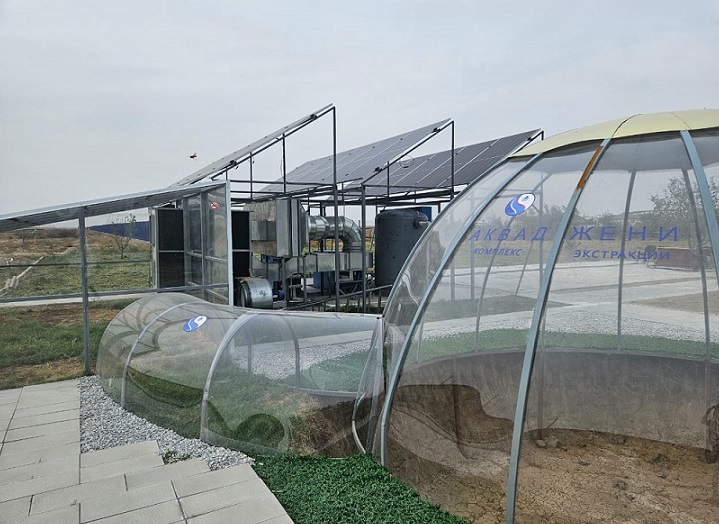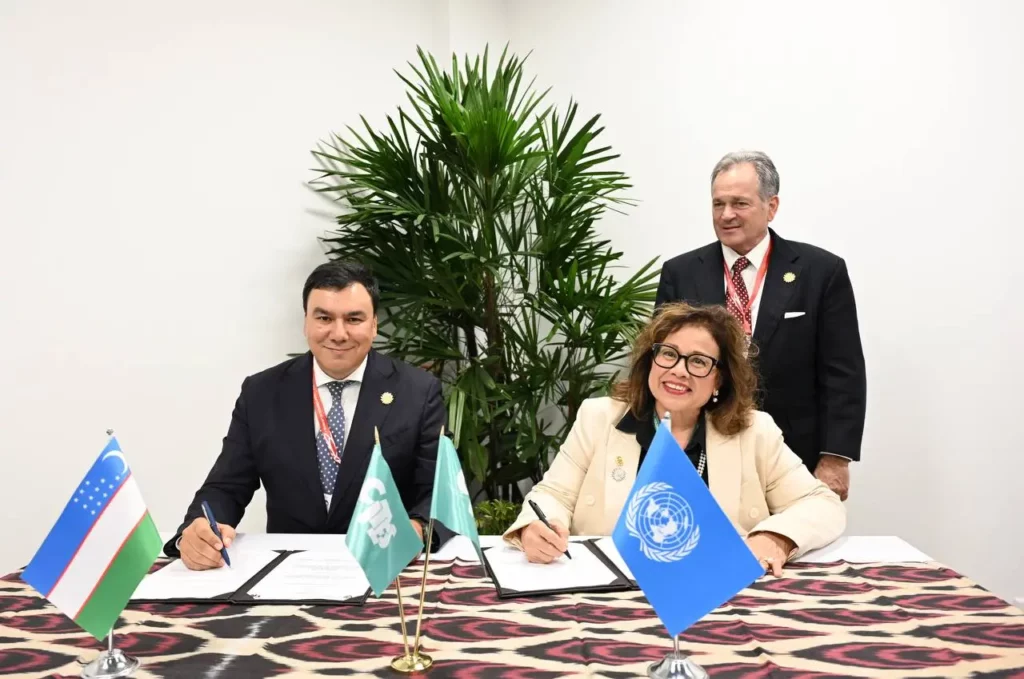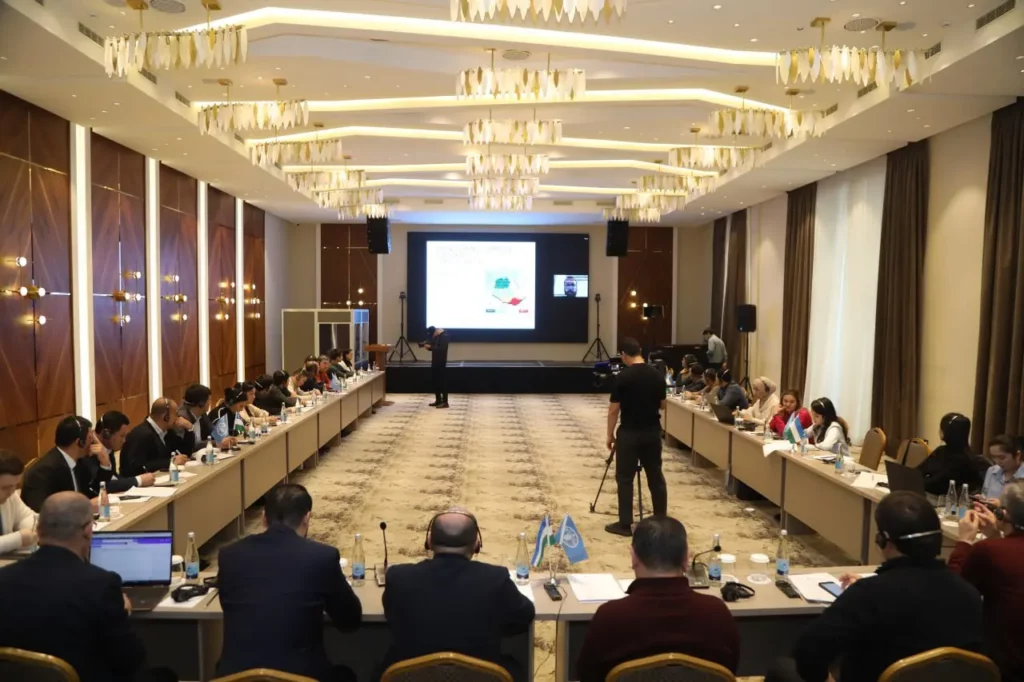In the Uzbek FEZ “Navoi” equipment that has no analogues in the world was successfully tested.

The world’s first installation for extracting drinking water from air in hot and dry climate conditions has been successfully tested in the Navoi Free Economic Zone (FEZ).
The equipment, developed and manufactured by the Russian company Aquagenica and having passed the most serious tests in Uzbekistan, is capable of producing 1000 liters of water per day. Its big advantages include low energy consumption, which allows using renewable energy sources – sun and wind. The director of the FEZ “Navoi” Khabib Abdullaev told Fergana about the unique development.
And the story began like this…
In early 2019, Moscow native Khabib Abdullaev was invited to work in Uzbekistan and appointed head of the Navoi FEZ. Within a few months of his arrival, he realized that the country had several key problems that had no universal solution, such as water shortages.
“Since the President of Uzbekistan Shavkat Mirziyoyev declared the Navoi region a high-tech and innovation zone in May 2019, I began to pay attention to foreign scientific developments in the fields of energy efficiency and water conservation,” says Abdullaev. “I was especially attracted to the topic of water in the context of combating desertification, and there was a personal reason for that. In the late 1950s, my grandfather, who headed the Academy of Sciences of Uzbekistan, tried to achieve the creation of an all-Union scientific center for the study of the desert in Tashkent, but his premature death prevented these plans.”
Then the search for promising projects began, several options were considered. As a result, Abdullaev’s attention was drawn to information about the technology of water extraction from atmospheric air “Air Spring”, developed by the Russian scientist Sergei Dorzhiev. At that time, he headed the laboratory of renewable energy sources of the Federal Scientific Agroengineering Center VIM.

According to Abdullaev, the technology developed by Dorzhiev had a number of advantages over foreign analogues. For example, the equipment consumed relatively little electricity, which allowed it to be “powered” by small solar or wind installations. In addition, it was easy to operate and not subject to breakdowns.
But most importantly, calculations showed that the water extraction plant could operate in very dry air, which is extremely important for most countries with high water stress.
As Abdullaev recalls, he managed with great difficulty to contact Dorzhiev and invite him to Central Asia, but the COVID-19 pandemic intervened.
“In 2022, we met in Moscow and agreed that Uzbekistan is the best place to test this technology,” Abdullaev said.
By the way, at the same time Dorzhiev and his team of specialists organized Aquagenica LLC together with an investor. It took another year and a half to convince the investor to place the pilot project in Uzbekistan, and not in one of the countries of the Persian Gulf, Africa or India, the head of the FEZ added.
Know-how from Navoi
As a result, in the spring of 2024, the Russian company decided to launch the project in Uzbekistan, and the main elements of the equipment were sent to the free economic zone. Some components were purchased or manufactured locally. Specialists had to work in the evening and at night, since the daytime heat in Navoi is unbearable.
In July, the world’s first plant for extracting water from dry air was launched.
“The results exceeded our expectations,” Abdullaev states. “The plant’s productivity was at an acceptable level – 850 liters per day with a calculated value of 1,000 liters, and the quality of the water, as shown by studies in three different laboratories in Russia and Uzbekistan, met the strictest standards.”
In the following period, there was a “fine” adjustment of the equipment, a study of the parameters for the period, which made it possible to achieve the calculated volumes.

And here is what the creator of the know-how and head of the Russian company Aquagenica, Sergei Dorzhiev, says about his brainchild:
“As a result of many years of research, we have managed to create an unpretentious machine that operates in extreme conditions of a hot and dry climate with a water content of 4 g/m3 and higher in the atmospheric air and in a temperature range of 10-70 degrees Celsius. At the same time, foreign analogues extract water from the air at a humidity of 8-10 g/m3 of air and higher in a temperature range of 25-38 °C. Or, as they claim, from 20-40 °C. We expect that our installation will help solve problems with access to good quality drinking water.”
Khabib Abdullaev believes that the launch of the plant is of historic nature. According to him, the new technology will once and for all solve the problem of access to quality drinking water in remote or hard-to-reach areas.
“First of all, this concerns children, since the low quality of water has the most detrimental effect on their health. The burden on healthcare will decrease, which will allow part of the costs to be redirected to other social needs. In addition, autonomous water sources will help stop desertification, facilitate the development of new deposits, the work of geologists, shift workers, military personnel and many other specialists,” he emphasized the advantages of the project.

Information about the unique technology that has received a “registration” in Uzbekistan would be incomplete without indicating the price of the installation. But there are no specifics on this issue yet. As the director of the FEZ said, Aquagenica is currently completing the calculation of the cost price for serial production of equipment in the Navoi region.
“Fortunately, our region has a number of modern enterprises in the field of mechanical engineering and metalworking, which makes the task much easier. Probably, by mid-November, information on prices will appear. It is already obvious that the level of localization will initially exceed 50%,” explained the head of the FEZ “Navoi”.
However, it is known that it is planned to produce at least 500 drinking water extraction units per year. It is expected that mass production will begin in 2025 on the territory of the Navoi FEZ. Abdullaev specified that most of the products will be exported. At least 30 countries in Africa and Asia have shown interest in purchasing the unique units.
“However, I consider the final resolution of the drinking water issue in Uzbekistan to be a priority,” Abdullaev summed up.
https://asiaplustj.info/ru/news/centralasia/20241021/v-uzbekistane-hotyat-proizvodit-pitevuyu-vodu-iz-vozduha



